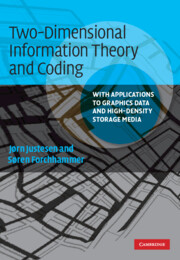 Two-Dimensional Information Theory and Coding
Two-Dimensional Information Theory and Coding Published online by Cambridge University Press: 05 June 2012
Introduction
In Chapter 3 we introduced linear error-correcting codes, and discussed how long codes can be obtained from short codes by the product construction. Reed–Solomon (RS) codes over larger alphabets were presented in Chapter 4, where we discussed the Datamatrix format as an example of how RS codes can be used to protect binary data. In this chapter we continue the analysis of these themes insofar as they relate to error correction in video and other applications.
We describe constructions of long error-correcting codes that are suitable for encoding of two-dimensional (2-D) media. The size of the pages makes it desirable to have relatively long codes, and 2-D constructions are often used to obtain long codes. However, there is not necessarily a link between the 2-D structure of the media and the code. In the last section we suggest that very long codes could be given a structure that would allow the 2-D structures to be connected, and that such a code could be partially decoded in cases in which only a subset of the data has to be retrieved.
Binary images of Reed–Solomon codes
The RS codes that are used in applications are always based on the fields F(2m). Here m = 8 is the traditional choice, but future applications are likely to use larger fields. As discussed in Section 4.6, the field is often constructed from a so-called primitive polynomial, p(z).
To save this book to your Kindle, first ensure [email protected] is added to your Approved Personal Document E-mail List under your Personal Document Settings on the Manage Your Content and Devices page of your Amazon account. Then enter the ‘name’ part of your Kindle email address below. Find out more about saving to your Kindle.
Note you can select to save to either the @free.kindle.com or @kindle.com variations. ‘@free.kindle.com’ emails are free but can only be saved to your device when it is connected to wi-fi. ‘@kindle.com’ emails can be delivered even when you are not connected to wi-fi, but note that service fees apply.
Find out more about the Kindle Personal Document Service.
To save content items to your account, please confirm that you agree to abide by our usage policies. If this is the first time you use this feature, you will be asked to authorise Cambridge Core to connect with your account. Find out more about saving content to Dropbox.
To save content items to your account, please confirm that you agree to abide by our usage policies. If this is the first time you use this feature, you will be asked to authorise Cambridge Core to connect with your account. Find out more about saving content to Google Drive.